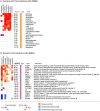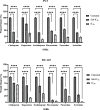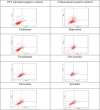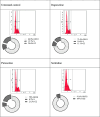Unraveling the Anticancer Potential of SSRIs in Prostate Cancer by Combining Computational Systems Biology and In Vitro Analyses
- PMID: 40290959
- PMCID: PMC12019733
- DOI: 10.1021/acsomega.4c10939
Unraveling the Anticancer Potential of SSRIs in Prostate Cancer by Combining Computational Systems Biology and In Vitro Analyses
Abstract
Selective serotonin reuptake inhibitors (SSRIs) are known to have anticancer activity against different types of cancer. In this study, an integrative informatics approach was applied to identify compound and genetic perturbations that produce similar effects to SSRIs to formulate systems biology hypotheses and identify biological pathways involved in the putative anticancer effects of SSRIs in prostate cancer. An 3-(4,5-dimethylthiazol-2-yl)-2,5-diphenyltetrazolium bromide (MTT) assay assessed the antiproliferative effects of SSRIs and drug combinations. Cell death mechanisms were studied using annexin V-FITC/PI staining, and the cell cycle analysis was carried out by counterstaining with propidium iodide. Relative gene expression was assessed using a real-time polymerase chain reaction (PCR). Computational results hypothesized that SSRIs could potentially exert anticancer effects in prostate cancer cell lines by modulating apoptotic and tumorigenesis pathways and significantly inhibiting the growth of prostate cancer cells in a time and concentration-dependent manner. The combination of SSRIs with cisplatin, 5-fluorouracil, and raloxifene resulted in either synergistic or additive effects. SSRIs resulted in a significant increase in the early and late apoptotic activity in PC3 cells. Dapoxetine, paroxetine, and sertraline resulted in cell cycle arrest at the G0/G1 phase. Treatment with either dapoxetine or paroxetine decreases the expression of Bcl-2, CASP8, DR5, and VEGF. At the same time, sertraline decreases the expression of Bcl-2 and VEGF and increases the expression of CASP8 and DR5. Results revealed that SSRIs can potentially act as antiproliferative agents against prostate cancer cells, and their activity is mediated through different signaling pathways.
© 2025 The Authors. Published by American Chemical Society.
Conflict of interest statement
The authors declare no competing financial interest.
Figures










References
-
- Chu A.; Wadhwa R.. Selective serotonin reuptake inhibitors StatPearls, 2021. - PubMed
-
- Hirsch M.; Birnbaum R. J.. et al.Selective serotonin reuptake inhibitors: Pharmacology, administration, and side effects. UpToDate, UpToDate, Roy-Byrne P. P.; Solomon D., Eds. 2017.
LinkOut - more resources
Full Text Sources
Research Materials
Miscellaneous
